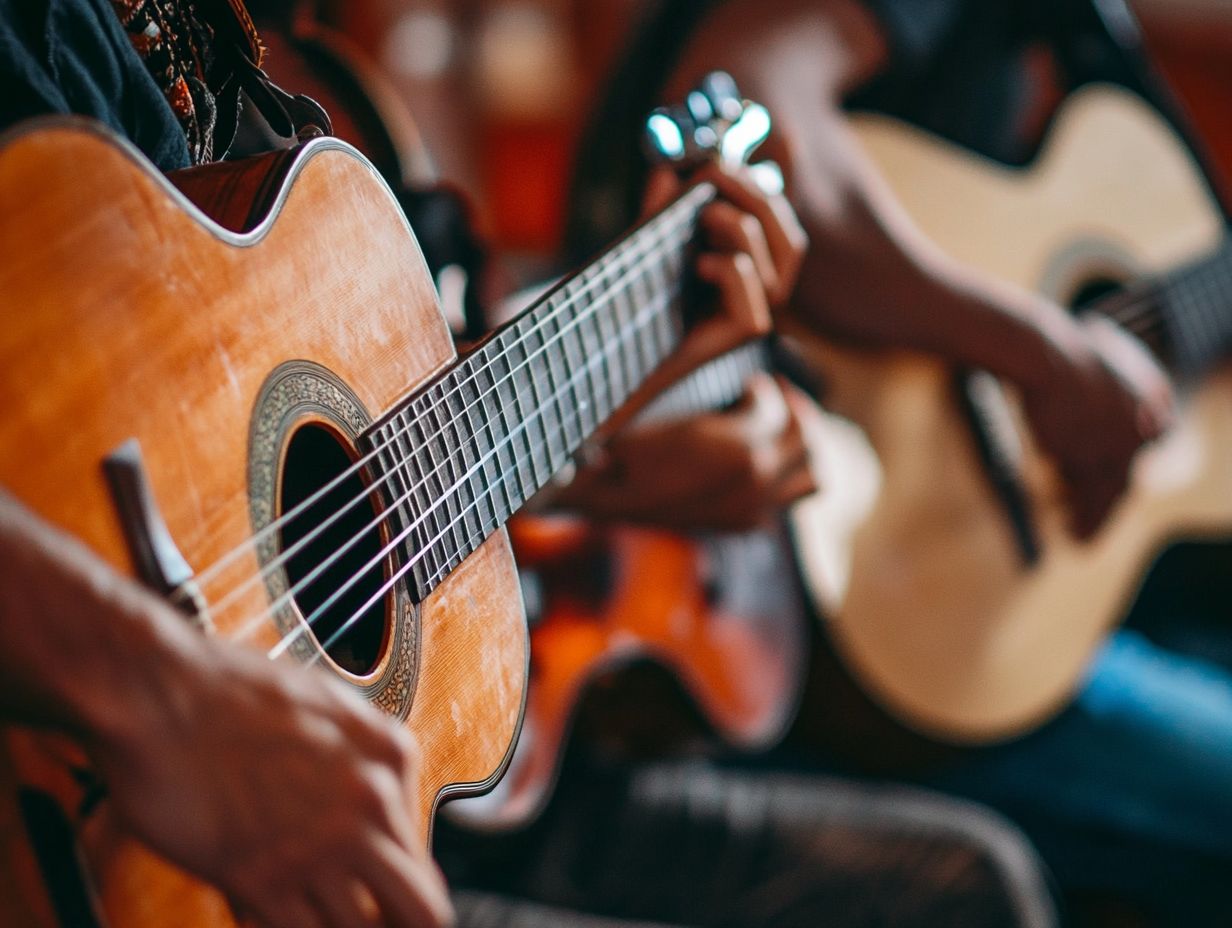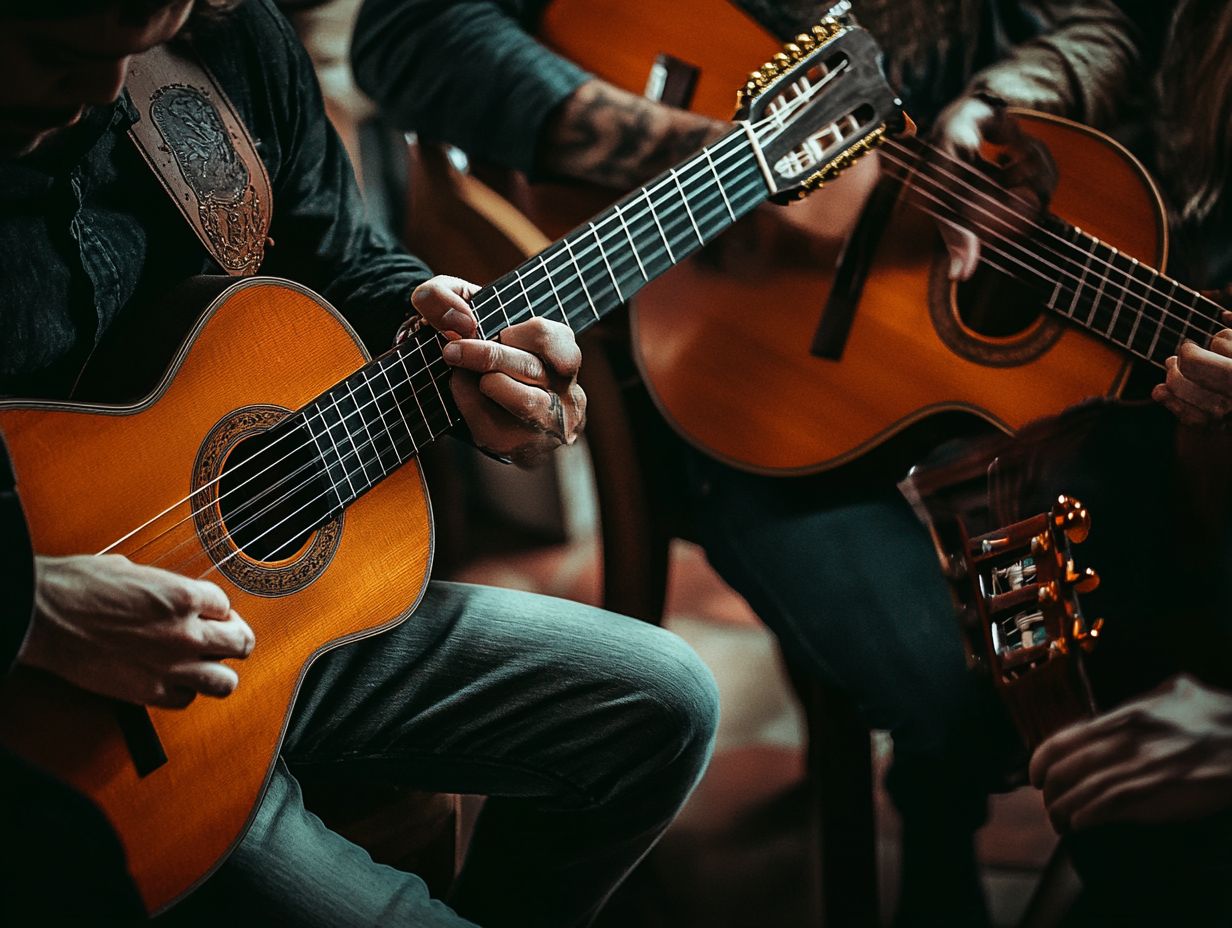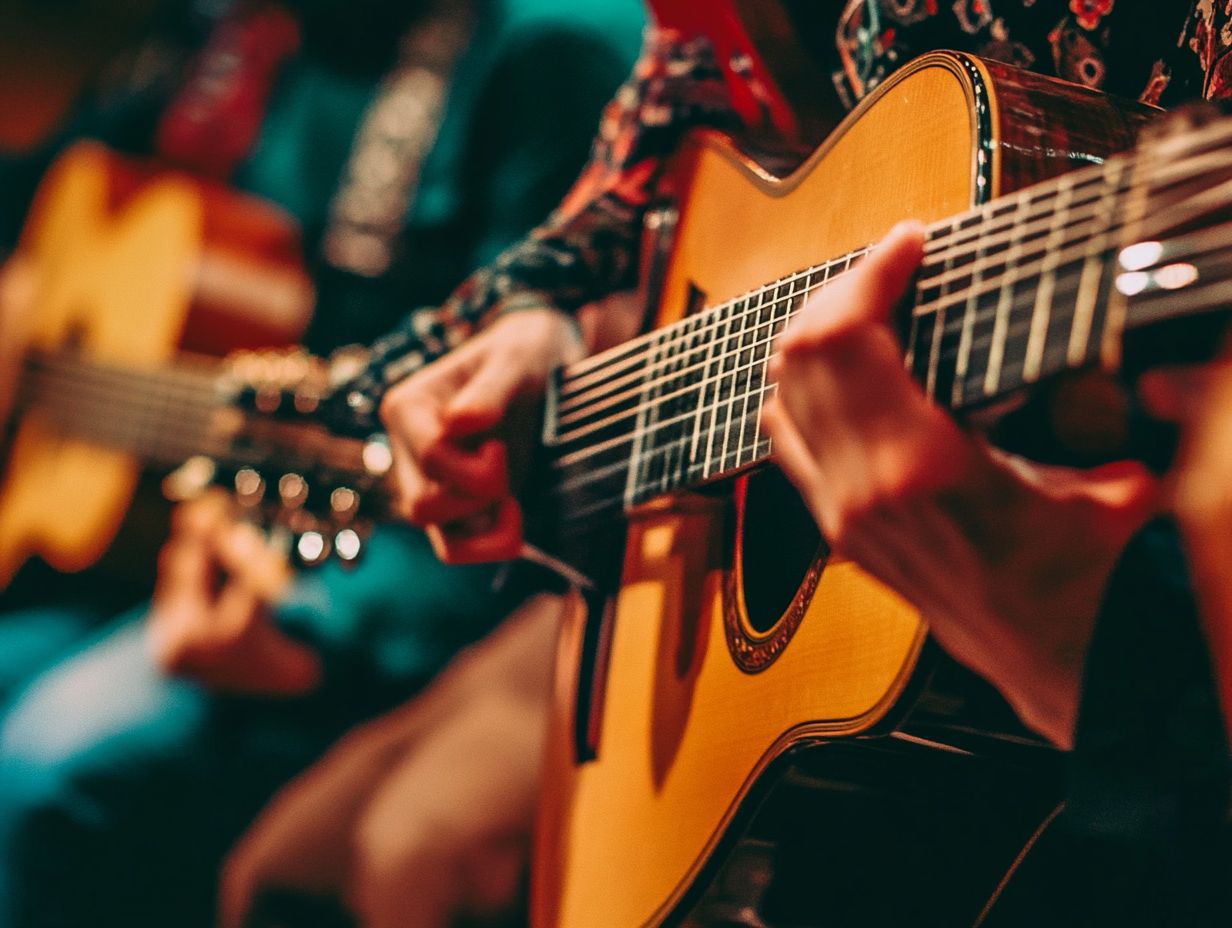Guitars have captivated music lovers for centuries, serving as the backbone of countless genres and styles. This exploration delves into the rich history and evolution of guitars, contrasting acoustic and electric varieties while highlighting popular designs.
It takes you through various genres, from the electrifying riffs of rock and roll to the soulful melodies of blues and jazz, showcasing famous guitarists who have influenced these musical styles.
Additionally, you will find tips for selecting the right guitar to match your musical taste, along with essential maintenance advice to keep your instrument in top condition.
Join us in celebrating the versatility of this beloved instrument.
Contents
The History of Guitars

The history of guitars spans several centuries, with the instrument appearing in various forms throughout time. Guitars are stringed instruments that are either plucked or strummed to produce sound, belonging to a family of instruments that includes historical predecessors such as the lute and oud. Over the ages, the guitar has evolved, influenced by a variety of cultures that have contributed to the development of different types of guitars.
Today, the two principal types of guitars are acoustic guitars and electric guitars. Acoustic guitars, which include classical and flamenco guitars, produce sound without electronic amplification, relying on their hollow bodies to create resonance. In contrast, electric guitars require amplification and typically feature solid bodies.
The earliest guitars were similar to the lute, an instrument with roots dating back to 500 BC in the Middle East. The guitar began to take on a distinct shape in Italy during the 15th century, when strumming became the primary method of sound production, replacing the original plucking technique. The first guitars had four pairs of strings, but by the end of the 18th century, the design had evolved into the six-string model we commonly use today.
As the guitar gained popularity, it became associated with various music genres and styles, with contributions from Spanish guitarists, 19th-century Romanticism, and American folk music. The invention of steel strings in the 19th century enabled guitarists to play with greater volume and clarity, ushering the instrument into a golden age of recordings and performances.
In modern times, guitars are produced at various price points and levels of complexity. Some of the most renowned guitar brands, such as Fender, Gibson, and Ibanez, have made significant contributions to music history. While traditional guitars were primarily made from wood and metal, contemporary electric guitars also incorporate materials like plastic and carbon fiber. Guitars are among the most versatile instruments in the world, played across every culture and musical genre, from rock and jazz to flamenco and blues.
Origins and Evolution
The origins and evolution of the guitar can be traced back to ancient civilizations, where the first stringed instruments emerged, laying the groundwork for contemporary styles and genres of music. Early versions, such as the lyre and lute, were crafted with remarkable skill, showcasing the artisans’ expertise and the cultural significance of music during their time.
As societies evolved, these instruments underwent significant changes, influenced by the various musical traditions from different parts of the world. In Spain, for instance, the evolution of the classical guitar in the 18th century marked a decisive moment, as it combined intricate craftsmanship with the lively flamenco style.
Concurrently, the spread of the instrument throughout Europe and into the Americas introduced innovations that would shape modern guitar design, culminating in the development of the electric guitar during the 20th century. This evolution reflects not only technological advancements but also the shifting musical landscapes that embraced genres such as blues, rock, and jazz, further enriching the guitar’s legacy in the world of music.
Types of Guitars
There are many different types of guitars, and understanding these variations is essential for anyone who plays or enjoys music. Each type of guitar possesses unique qualities and functions that make it more or less suitable for specific genres or playing styles.
Acoustic vs Electric
The primary difference between acoustic and electric guitars lies in their sound and tone. Acoustic guitars produce a warmer, more natural tone, making them well-suited for folk, classical, and other melodic styles of music.
In contrast, electric guitars offer a wider tonal range, allowing guitarists to create sounds that can be bright and crisp or deep and throaty, depending on the style of music being played. Electric guitars are particularly favored in genres such as rock, blues, jazz, and other more modern styles.
The playing techniques also differ significantly. Strumming an acoustic guitar typically results in a fuller sound compared to an electric guitar, which may have a thinner tone when strummed. Additionally, electric guitarists can further modify their tones using effects pedals and amplifiers.
Popular Styles and Designs

The styles and designs of guitars are significantly influenced by musicians’ preferences as well as the cultural elements present in various music genres. This highlights the importance of both aesthetics and functionality in the craftsmanship of instruments.
These factors are evident in the classic designs associated with major brands, as well as in the growing popularity of custom guitars that reflect individual preferences and playing styles. For instance, the Fender Stratocaster and Gibson Les Paul are two iconic models that have become staples for rock and blues electric guitarists, illustrating how design can impact sound and playability.
Musicians often select these models not only for their rich, warm tones but also for their stunning visual appeal. Whether it is the sleek, contoured body shape of the Stratocaster or the intricate fingerboard inlays on the Les Paul, the interplay between design and a guitarist’s unique musical context is crucial to their overall expression and artistry.
Guitars in Different Genres
Guitars play a vital role in a wide range of musical genres, including rock and roll, jazz, blues, country, and pop, showcasing their versatility as an instrument.
Rock and Roll
Rock and roll has played a pivotal role in defining the electric guitar’s place in popular music, with powerful guitar riffs and solos becoming iconic elements of the genre. From the thunderous opening of Led Zeppelin’s “Whole Lotta Love” to the intricate melodies of Jimi Hendrix’s “Voodoo Child,” the electric guitar serves as the heartbeat of countless hits that have shaped the soundscape of rock music.
These unforgettable riffs not only capture the listener’s attention but also evoke a sense of rebellion and passion that is synonymous with the genre. Iconic solos, such as Eric Clapton’s emotional performance in “Layla” and Eddie Van Halen’s high-energy shredding in “Eruption,” showcase the instrument’s versatility and technical prowess.
These songs exemplify how the electric guitar has been a vital force in rock, inspiring generations of musicians and enthusiasts alike.
Country
In country music, the acoustic guitar is celebrated for its warm tones and versatility, incorporating techniques such as fingerstyle and strumming that enhance the genre’s rich storytelling tradition.
This beloved instrument serves as the backbone for countless songs, enabling musicians to convey deep emotions through resonant chord progressions. Fingerstyle techniques allow artists to pluck individual strings, creating intricate melodies that seamlessly intertwine with the narrative.
In contrast, rhythmic strumming patterns provide an irresistible drive, evoking the lively spirit of country music. Each strum and pluck not only showcases musical expression but also captures the essence of the stories that artists aim to tell, making the acoustic guitar an essential part of the genre’s identity.
Blues

The blues genre has significantly influenced the development of guitar techniques, placing a strong emphasis on improvisation skills and the scales that convey the genre’s emotional depth. This impact is evident in the expressive tones and emotive notes of legendary guitarists who have shaped the blues, such as B.B. King and Eric Clapton.
Their mastery of techniques like bending notes and using the pentatonic scale results in a sound that resonates deeply with listeners. Improvisation allows musicians to convey raw emotion as they blend their unique styles with those of their influences.
As these artists skillfully navigate complex riffs and soulful solos, it becomes clear that both technique and emotion are essential elements in the ongoing evolution of the blues and serve as inspiration for aspiring guitarists everywhere.
Jazz
Jazz guitar is defined by intricate improvisation and complex harmony, with guitarists often employing sophisticated chord progressions and scales to create melodic richness. This improvisational element is essential to the genre, allowing players to delve into their creativity while responding to the dynamic rhythms of the accompanying ensemble.
Guitarists skillfully weave together harmonic structures that may include extended chords and altered scales, enabling them to produce a distinctive sound palette. Influential figures like Wes Montgomery and Joe Pass not only paved the way for innovative musical techniques but also demonstrated how to incorporate these complex elements into their performances, inspiring countless musicians.
The balance between technical proficiency and expressive freedom in jazz guitar truly enhances the overall impact of this captivating art form.
Folk
The acoustic guitar serves as the primary instrument in folk music, with its rhythmic strumming and melodic playing used to convey the stories and emotions embedded in the lyrics and narratives. Folk music is celebrated for its cultural narratives, and the acoustic guitar not only provides a backdrop for these lyrics but also enhances the overall sound of the genre.
Its versatility allows for various fingerpicking techniques that add layers of complexity to the songs, enabling musicians to express deeper emotions. Folk guitarists often employ techniques such as Travis picking and flatpicking, which are essential to the genre.
Notable figures like Woody Guthrie and Joan Baez have exemplified the use of these techniques, leaving a lasting impact on 20th-century folk music.
Pop
The guitar plays a crucial role in pop music by serving as a background instrument for catchy riffs and melodies that enhance the genre’s commercial appeal and accessibility.
This iconic instrument provides a strong foundation for many of today’s chart-topping hits, fostering a significant connection with listeners.
Famous Guitarists and their Signature Sounds

Renowned guitarists have made significant contributions to music history, each developing a unique sound that resonates across genres and serves as inspiration for aspiring musicians and guitar players.
Influential Musicians and their Impact on Genres
Influential musicians have significantly shaped the music landscape through their innovative guitar techniques and creative contributions, often redefining genres and inspiring future generations. These artists, originating from diverse backgrounds, have experimented with various playing styles, including fingerpicking, slide guitar, and intricate finger-tapping, ultimately pushing the boundaries of what is possible with the instrument.
For instance, the mastery of blues by legends such as B.B. King not only enhanced the emotional depth of songs but also established the foundation for rock and roll. Similarly, artists like Jimi Hendrix revolutionized the use of distortion and effects, creating soundscapes that forever altered the perception of guitar music.
Their contributions underscore their pivotal roles in the evolution of guitar music, leaving an indelible mark on subsequent musicians and the genres they explored.
How to Choose the Right Guitar for Your Preferred Genre
Selecting the right guitar for your genre requires an understanding of the characteristics of different instruments and how they align with your goals and playing techniques.
Factors to Consider
When selecting a guitar, several factors come into play, including sound quality, tuning stability, pickup types, and string gauges, all of which significantly impact your playing experience. Each of these elements contributes uniquely to the instrument’s overall character.
Sound quality encompasses tonal richness and clarity, which are often influenced by the type of wood used for the body and neck. Tuning stability is particularly crucial for those who perform regularly; quality tuning pegs and nut materials can help keep the instrument in tune for extended periods. The type of pickup—whether single-coil or humbucker—can profoundly affect the sound profile, influencing various aspects of the instrument such as sustain and warmth.
Lastly, string gauge plays a vital role in playability, affecting both the feel and tonal response of the guitar. By understanding these factors, you can make a more informed decision that aligns with your musical goals.
Maintaining and Caring for Your Guitar
Maintaining and caring for your guitar are essential for ensuring that your instrument functions like new for as long as possible. Proper cleaning and upkeep of a guitar require careful attention to detail.
Tips for Proper Maintenance
Proper maintenance of your guitar involves cleaning, careful handling, and using accessories that protect the instrument and preserve sound quality. If not performed correctly, this maintenance can lead to wear and tear that negatively affects both performance and longevity.
A simple yet effective maintenance habit is to wipe down the strings and body with a soft, lint-free cloth after each session to remove oil and dirt buildup. Investing in a quality guitar stand can help prevent accidental falls and damage, while storing the guitar in its case when not in use is also essential.
Regularly changing the strings is important for maintaining sound clarity, and utilizing a humidifier can help maintain the moisture level in the air, which is particularly vital for acoustic guitars.
Following these maintenance best practices not only protects the guitar’s finish but also plays a crucial role in ensuring it sounds its best.
